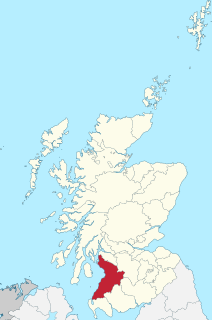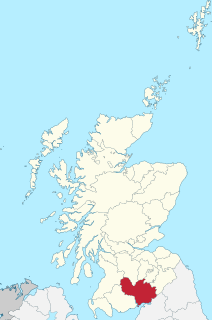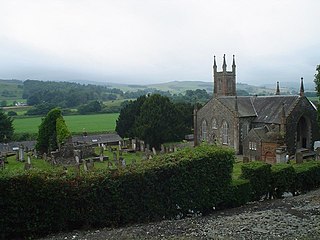
Ayrshire is a historic county and registration county in south-west Scotland, located on the shores of the Firth of Clyde. Its principal towns include Ayr, Kilmarnock and Irvine and it borders the counties of Renfrewshire and Lanarkshire to the north-east, Dumfriesshire to the south-east, and Kirkcudbrightshire and Wigtownshire to the south. Like many other counties of Scotland it currently has no administrative function, instead being sub-divided into the council areas of North Ayrshire, South Ayrshire and East Ayrshire. It has a population of approximately 366,800.

Dumfries and Galloway is one of 32 unitary council areas of Scotland and is located in the western Southern Uplands. It comprises the historic counties of Dumfriesshire, Kirkcudbrightshire, and Wigtownshire, the latter two of which are collectively known as Galloway. The administrative centre and largest settlement is the town of Dumfries. The second largest town is Stranraer, 75 miles to the west on the Irish Sea coast.

Dumfriesshire or the County of Dumfries is a historic county, registration county and lieutenancy area of southern Scotland.

The River Nith is a river in south-west Scotland. The Nith rises in the Carsphairn hills of East Ayrshire, more precisely between Prickeny Hill and Enoch Hill, 4.4 miles (7.1 km) east of Dalmellington. For the majority of its course it flows in a south-easterly direction through Dumfries and Galloway and then into the Solway Firth at Airds Point.

The Siebe Gorman Salvus is a light oxygen rebreather for industrial use or in shallow diving. Its duration on a filling is 30 to 40 minutes. It was very common in Britain during World War II and for a long time afterwards. Underwater the Salvus is very compact and can be used where a diver with a bigger breathing set cannot get in, such as inside cockpits of ditched aircraft. It was made by Siebe Gorman & Company, LTD in London, England. It was designed in the early 1900s.

The River Garnock, the smallest of Ayrshire's six principal rivers, has its source on the southerly side of the Hill of Stake in the heart of the Clyde Muirshiel Regional Park. About a mile and a half south of this starting point the untested stream tumbles over the Spout of Garnock, the highest waterfall in Ayrshire, once thought to be the river's origin. The river then continues, for a total length of 20 miles (32 km) or so, through the towns of Kilbirnie, Glengarnock, Dalry and Kilwinning to its confluence with the River Irvine at Irvine Harbour.

"Sweet Afton" is a lyrical poem describing the Afton Water in Ayrshire, Scotland. It was written by Robert Burns in 1791 and set to music by Jonathan E. Spilman in 1837, under the title Flow gently, sweet Afton. This poem was originally published by Burns in the Scots Musical Museum as a song, still sung today as published.

New Cumnock is a town in East Ayrshire, Scotland. It expanded during the coal-mining era from the late 18th century, and mining remained its key industry until its pits were shut in the 1960s. The town is 5.7 miles (9.2 km) south-east of Cumnock, and 21 miles (34 km) east of Ayr.

Connel Burn is a river in East Ayrshire, Scotland which rises at Enoch Hill in the Southern Uplands and flows northwards through Laglaf and Connel Park before meeting the River Nith in New Cumnock.

The Knockshinnoch disaster was a mining accident that occurred in September 1950 in the village of New Cumnock, Ayrshire, Scotland. A glaciated lake filled with liquid peat and moss flooded pit workings, trapping more than a hundred miners underground. For several days rescue teams worked non-stop to reach the trapped men. Most were eventually rescued three days later, but 13 died. The disaster was an international media event.

The Carsphairn and Scaur Hills are the western and eastern hills respectively of a hill range in the Southern Uplands of Scotland. Ordnance Survey maps don't have a general name for the hill area as a whole. Also, Ordnance Survey use "Scar" rather than the local spelling of "Scaur" - the word is pronounced as "Scar" however. In their Landranger Series of maps, it requires four separate sheets to cover the area.

Black Loch is a freshwater loch, named from its dark waters, situated in the East Ayrshire Council Area, between Cumnock and New Cumnock, lying in a glacial Kettle Hole mainly within the Parish of New Cumnock, a small portion protruding into Old Cumnock Parish. It is said to be one of only two lochs or lakes in the world that have outflows running to two separate destinations. The 'Runner' is a deep and broad ditch that was dug many years back to link the three lochs of Lowes, Black, and Creoch.

Creoch Loch, previously known as Little Creoch Loch, is a freshwater loch in the Parish of New Cumnock in the East Ayrshire Council Area between Cumnock and New Cumnock, Scotland. It is located in a glacial kettle hole and is one of three linked lochs.

Loch o' th' Lowes, Lochside or Meikle Creoch Loch is a freshwater loch in the Parish of New Cumnock in the East Ayrshire Council Area, Scotland. One of three linked lochs, it is overlooked by the A76 road and is located in a glacial kettle hole.

Glencairn is an ecclesiastical and civil parish in Dumfries and Galloway, Scotland.

The Glaisnock Water is a tributary of the Lugar Water in East Ayrshire, Scotland. It passes under the Glaisnock Viaduct. The source is located south of the town of Cumnock, through which it flows.
Events from the year 1950 in Scotland.

Deil's Dyke, Pict's Dyke or Celt's Dyke in south-west lowland Scotland is a linear earthwork that roughly follows the contours that divide upland pasture from lowland arable land, effectively acting like the head-dykes of medieval and later times although its true purpose has not been settled. The Deil's Dyke, sometimes written as 'dike', is formed from an earthen berm of rounded form that varies from 2.0-4.0m wide and a maximum of 0.7m high sometimes having a stone core. Where a fosse accompanies the bank it is usually an inconsequential 0.5m or so in width on average and around 0.4m deep, more often located on the uphill or outfield side. As a defensive structure the dyke has no obvious military value and its erratic route militates against it being a practical political boundary.



















